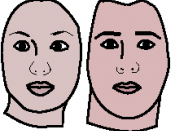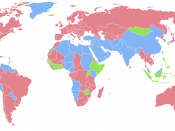Invisible Ceiling As I conducted my survey, I found that gender is a social and cultural attribute that helps society determine whether or not a specific quality or trait is masculine or feminine.
From the results of the survey, I was able to conclude that societies views essential qualities a leader should have as being in direct correlation with Masculine Leadership traits. After surveying twenty-five people, thirteen males and twelve females, 60 percent or more thought the traits "Achiever, Aggressive, Confident, Dynamic, Achiever, Powerful, and Strong" were essential qualities for a leader to have. All seven traits are Masculine. This helps us understand more clearly why Males are elected to higher leadership positions more often then females. For example, there has never been a female president elected into office, because society looks for a leader to have traits that are Masculine.
There is always an exception. Not all essential qualities of a leader in direct correlation with Masculine traits.
I found in my results one feminine trait that society viewed as an essential leadership quality. The trait "Organized" is a feminine trait that society looks for in a Leader.
Therefore, males might disapprove of a female holding a high administrative or governmental job because females might have no conception of men's problems. Due to societies belief that a leader should have masculine traits, is one factor that might lead us to the reason why employers tend to hire males regularly then females. This is a prime example of invisible ceiling, which is referred to as being the hidden obstacles which limits womens occupational advancement in the workforce because of how societies looks at them. Both women and men know how to be aggressive, and how to be helpful leaders. But over time societies begun to correlate aggressiveness and other traits associated with leaders as being masculine. Therefore, it's unwittingly caused females to be overlooked for promotions and has created negative bias when evaluating women's performance in a leadership position like superintendent.
Through interpreting the data collected through the survey, I am able to indicate what the statistic in a table titled "Income by Educational Level and Sex" would be. The statistic would show Males earning higher incomes then Females. If males and females had completed the same amount of education, males would hold a greater percentage of the senior level executive positions that pay top income salaries. Regardless of the educational level, males still would receive the higher paying jobs. This is evident because society views leaders as having masculine traits, as shown in the data from my survey I conducted. If a woman was masculine, it often makes people uncomfortable with her, because she is viewed differently because of a status inconsistency. On the other hand, if she is not masculine, which is how societies view of all females, a women might not be thought of as a person with leadership qualities, thus unqualified for the upper level administrative job.





